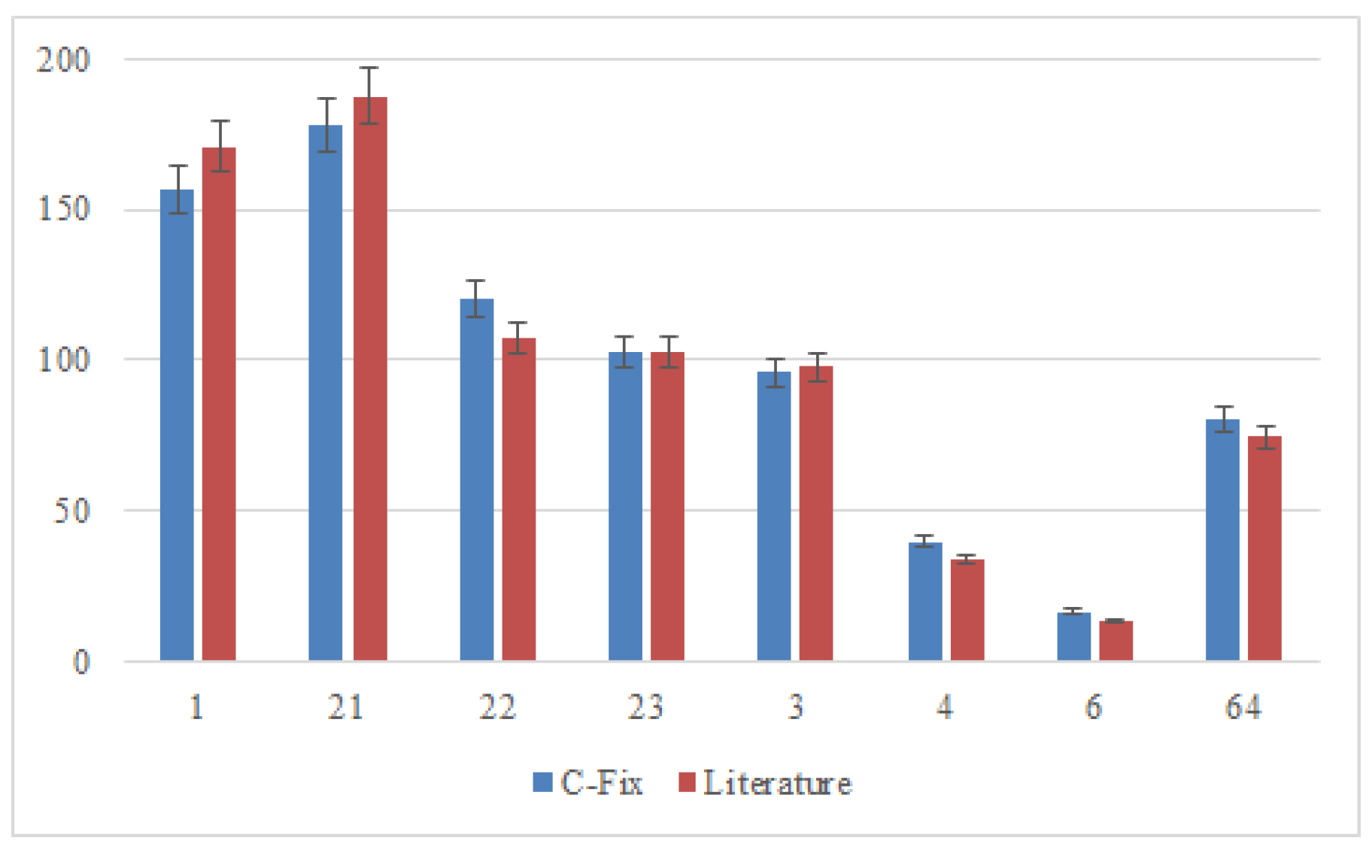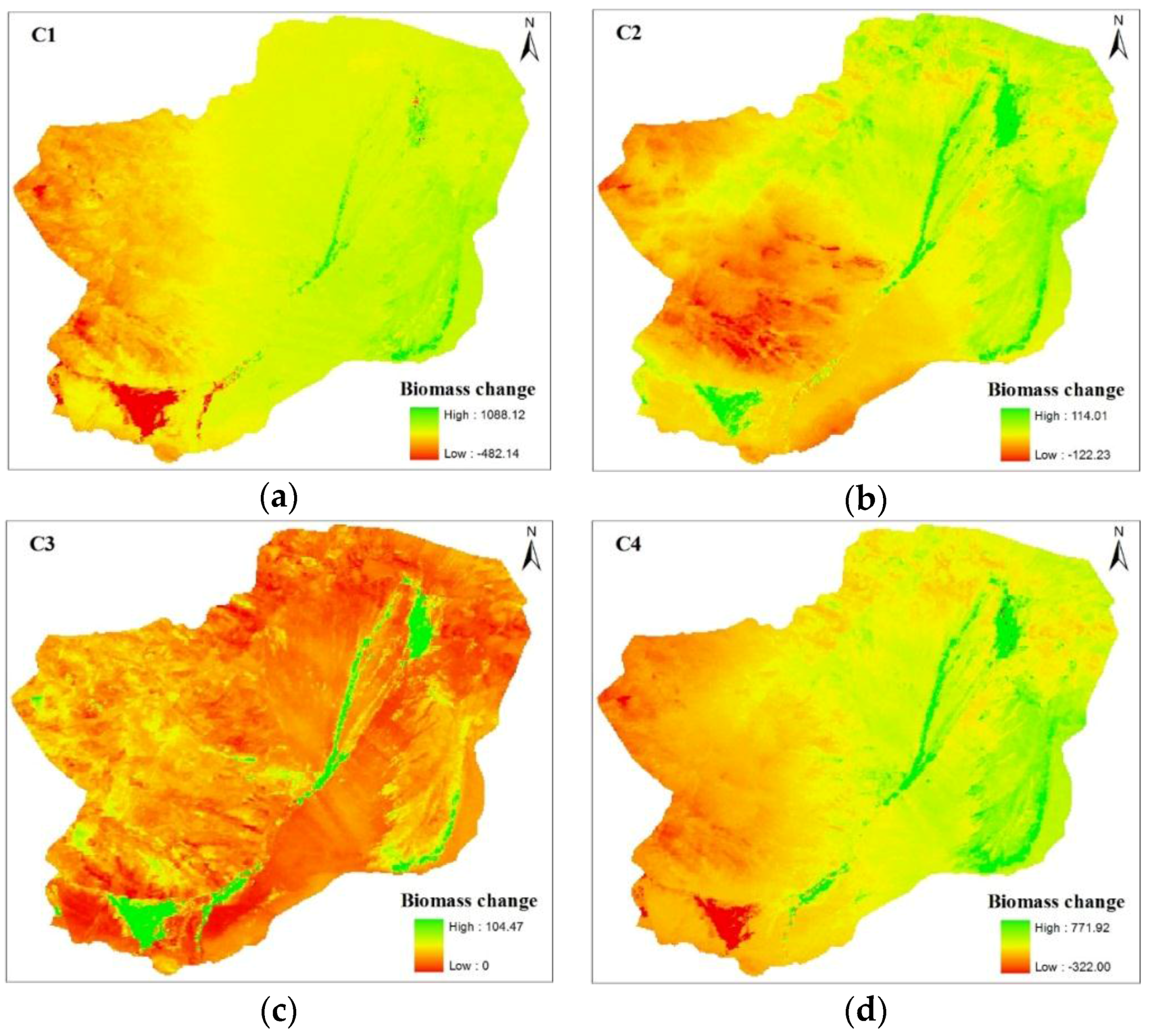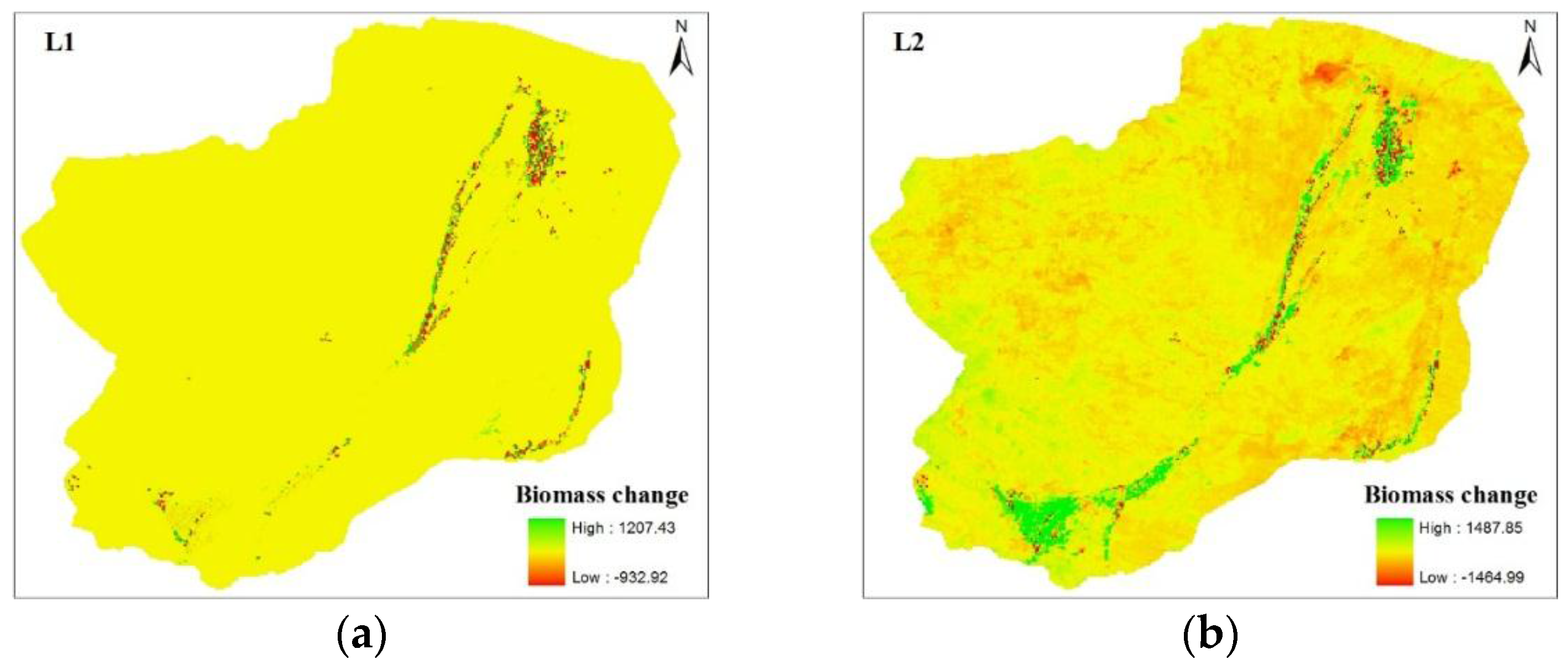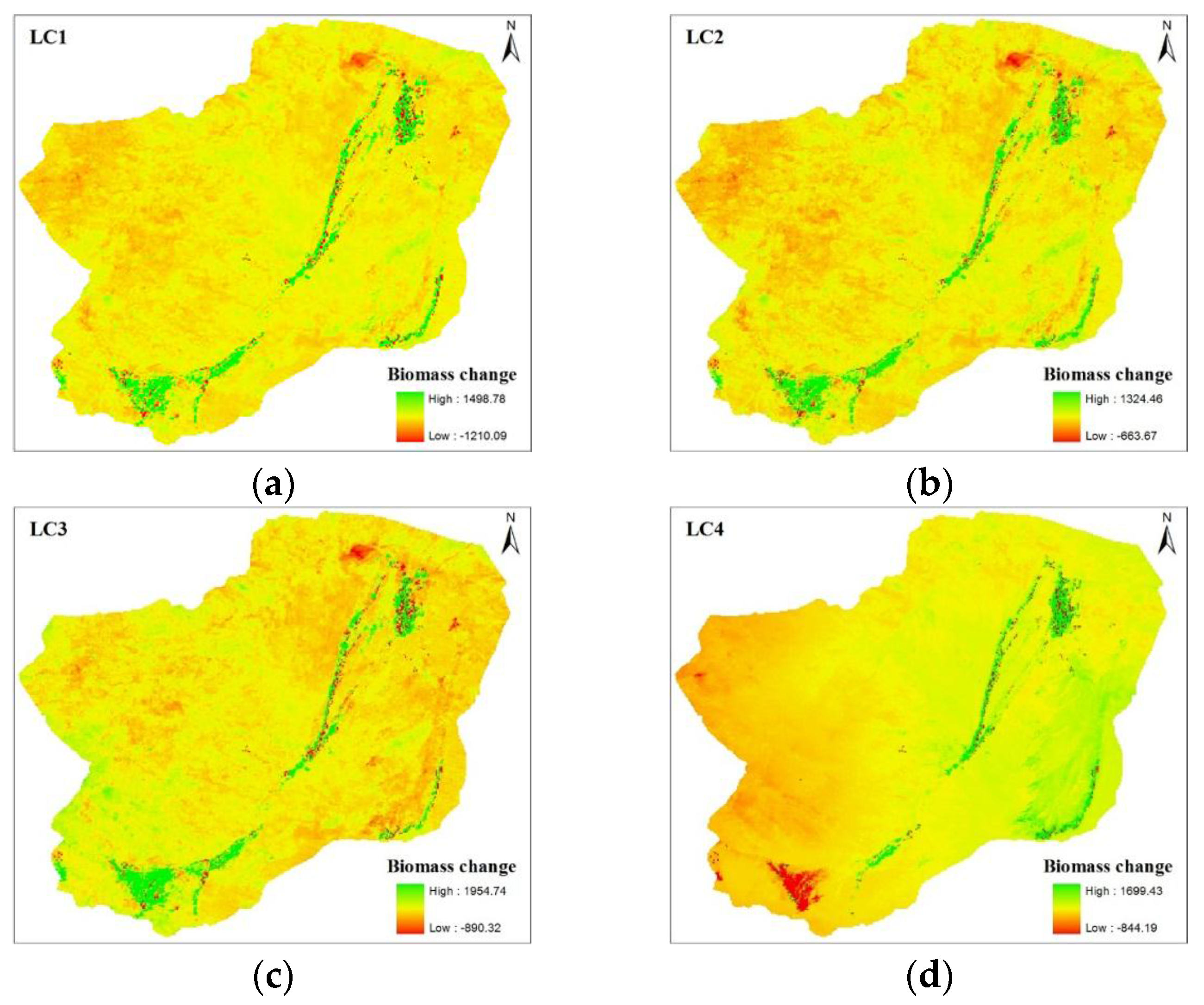Effects of Climate Change and LUCC on Terrestrial Biomass in the Lower Heihe River Basin during 2001–2010
Abstract
:1. Introduction
2. Materials and Methods
2.1. Study Area
2.2. C-Fix Model
2.3. Data and Parameters
2.4. Scenario Development
3. Results
3.1. Model Validation
3.2. Influence of Climate Change and LUCC on Biomass Accumulation
3.3. Effects of Climate Change on Biomass Accumulation
3.4. Effects of LUCC on Biomass Accumulation
3.5. Joint Effects of Climate Change and LUCC on Biomass Accumulation
4. Discussion
4.1. Model Uncertainties
4.2. Management Implications
5. Conclusions
Acknowledgments
Author Contributions
Conflicts of Interest
References
- Foley, J.A.; DeFries, R.; Asner, G.P.; Barford, C.; Bonan, G.; Carpenter, S.R.; Chapin, F.S.; Coe, M.T.; Daily, G.C.; Gibbs, H.K. Global consequences of land use. Science 2005, 309, 570–574. [Google Scholar]
- Biggs, R.; Schlüter, M.; Biggs, D.; Bohensky, E.L.; BurnSilver, S.; Cundill, G.; Dakos, V.; Daw, T.M.; Evans, L.S.; Kotschy, K. Toward principles for enhancing the resilience of ecosystem services. Annu. Rev. Environ. Resour. 2012, 37, 421–448. [Google Scholar]
- Burkhard, B.; Kroll, F.; Nedkov, S.; Müller, F. Mapping ecosystem service supply, demand and budgets. Ecol. Indic. 2012, 21, 17–29. [Google Scholar]
- Penttilä, T.; Laurila, T. Carbon dioxide and energy flux measurements in four northern-boreal ecosystems at pallas. Boreal. Environ. Res. 2015, 20, 455–473. [Google Scholar]
- Kobayashi, H.; Baldocchi, D.D.; Ryu, Y.; Chen, Q.; Ma, S.; Osuna, J.L.; Ustin, S.L. Modeling energy and carbon fluxes in a heterogeneous oak woodland: A three-dimensional approach. Agric. For. Meteorol. 2012, 152, 83–100. [Google Scholar] [Green Version]
- Al-Najjar, M.A.; De Beer, D.; Jørgensen, B.B.; Kühl, M.; Polerecky, L. Conversion and conservation of light energy in a photosynthetic microbial mat ecosystem. ISME J. 2010, 4, 440–449. [Google Scholar] [PubMed]
- Chen, S.; Chen, J.; Lin, G.; Zhang, W.; Miao, H.; Wei, L.; Huang, J.; Han, X. Energy balance and partition in Inner Mongolia steppe ecosystems with different land use types. Agric. For. Meteorol. 2009, 149, 1800–1809. [Google Scholar]
- Wilhelm, C.; Jakob, T. From photons to biomass and biofuels: Evaluation of different strategies for the improvement of algal biotechnology based on comparative energy balances. Appl. Microbiol. Biot. 2011, 92, 909–919. [Google Scholar]
- Nemani, R.R.; Keeling, C.D.; Hashimoto, H.; Jolly, W.M.; Piper, S.C.; Tucker, C.J.; Myneni, R.B.; Running, S.W. Climate-driven increases in global terrestrial net primary production from 1982 to 1999. Science 2003, 300, 1560–1563. [Google Scholar]
- Rojstaczer, S.; Sterling, S.M.; Moore, N.J. Human appropriation of photosynthesis products. Science 2001, 294, 2549–2552. [Google Scholar]
- Friend, A.D. Terrestrial plant production and climate change. J. Exp. Bot. 2010, 61, 1293–1309. [Google Scholar] [CrossRef]
- Texeira, M.; Oyarzabal, M.; Pineiro, G.; Baeza, S.; Paruelo, J.M. Land cover and precipitation controls over long-term trends in carbon gains in the grassland biome of South America. Ecosphere 2015, 6, 1–21. [Google Scholar]
- Yin, X.; Struik, P.C. Constraints to the potential efficiency of converting solar radiation into phytoenergy in annual crops: From leaf biochemistry to canopy physiology and crop ecology. J. Exp. Bot. 2015, 66, 6535–6549. [Google Scholar]
- Ferreira, R.A.; de Souza, J.L.; Lyra, G.B.; Escobedo, J.F.; Santos, M.V. Energy conversion efficiency in sugarcane under two row spacings in northeast of Brazil. Rev. Bras. Eng. Agric. Ambient. 2015, 19, 741–747. [Google Scholar]
- Caspersen, J.P.; Pacala, S.W.; Jenkins, J.C.; Hurtt, G.C.; Moorcroft, P.R.; Birdsey, R.A. Contributions of land-use history to carbon accumulation in US forests. Science 2000, 290, 1148–1151. [Google Scholar] [CrossRef] [PubMed]
- Feldhake, C.M.; Belesky, D. Photosynthetically active radiation use efficiency of dactylis glomerata and schedonorus phoenix along a hardwood tree-induced light gradient. Agrofor. Syst. 2009, 75, 189–196. [Google Scholar] [CrossRef]
- Zhang, Y.; Song, C.; Zhang, K.; Cheng, X.; Band, L.E.; Zhang, Q. Effects of land use/land cover and climate changes on terrestrial net primary productivity in the Yangtze River Basin, China, from 2001 to 2010. J. Geophys. Res. Biogeosci. 2014, 119, 1092–1109. [Google Scholar]
- Yin, F.; Deng, X.; Jin, Q.; Yuan, Y.; Zhao, C. The impacts of climate change and human activities on grassland productivity in Qinghai province, China. Front. Earth Sci. 2014, 8, 93–103. [Google Scholar] [CrossRef]
- Liu, J.; Zang, C.; Tian, S.; Liu, J.; Yang, H.; Jia, S.; You, L.; Liu, B.; Zhang, M. Water conservancy projects in China: Achievements, challenges and way forward. Glob. Environ. Chang. 2013, 23, 633–643. [Google Scholar] [CrossRef]
- Pan, S.; Tian, H.; Dangal, S.R.; Ouyang, Z.; Tao, B.; Ren, W.; Lu, C.; Running, S. Modeling and monitoring terrestrial primary production in a changing global environment: Toward a multiscale synthesis of observation and simulation. Adv. Meteorol. 2014, 2014, 1–17. [Google Scholar] [CrossRef]
- Tsubo, M.; Walker, S.; Mukhala, E. Comparisons of radiation use efficiency of mono-/inter-cropping systems with different row orientations. Field Crops Res. 2001, 71, 17–29. [Google Scholar] [CrossRef]
- Eullaffroy, P.; Frankart, C.; Aziz, A.; Couderchet, M.; Blaise, C. Energy fluxes and driving forces for photosynthesis in lemna minor exposed to herbicides. Aquat. Bot. 2009, 90, 172–178. [Google Scholar] [CrossRef]
- Calderini, D.F.; Dreccer, M.F.; Slafer, G.A. Consequences of breeding on biomass, radiation interception and radiation-use efficiency in wheat. Field Crops Res. 1997, 52, 271–281. [Google Scholar] [CrossRef]
- Beringer, J.; Chapin, F.S.; Thompson, C.C.; McGuire, A.D. Surface energy exchanges along a tundra-forest transition and feedbacks to climate. Agric. For. Meteorol. 2005, 131, 143–161. [Google Scholar] [CrossRef]
- Field, C.B.; Behrenfeld, M.J.; Randerson, J.T.; Falkowski, P. Primary production of the biosphere: Integrating terrestrial and oceanic components. Science 1998, 281, 237–240. [Google Scholar] [CrossRef] [PubMed]
- Gingrich, S.; Niedertscheider, M.; Kastner, T.; Haberl, H.; Cosor, G.; Krausmann, F.; Kuemmerle, T.; Müller, D.; Reith-Musel, A.; Jepsen, M.R. Exploring long-term trends in land use change and aboveground human appropriation of net primary production in nine European countries. Land Use Policy 2015, 47, 426–438. [Google Scholar] [CrossRef]
- Krausmann, F.; Erb, K.-H.; Gingrich, S.; Haberl, H.; Bondeau, A.; Gaube, V.; Lauk, C.; Plutzar, C.; Searchinger, T.D. Global human appropriation of net primary production doubled in the 20th century. Proc. Natl. Acad. Sci. USA 2013, 110, 10324–10329. [Google Scholar] [CrossRef] [PubMed]
- Mu, S.; Zhou, S.; Chen, Y.; Li, J.; Ju, W.; Odeh, I. Assessing the impact of restoration-induced land conversion and management alternatives on net primary productivity in Inner Mongolian grassland, China. Glob. Planet. Chang. 2013, 108, 29–41. [Google Scholar] [CrossRef]
- Peng, C.; Apps, M.J. Modelling the response of net primary productivity (NPP) of boreal forest ecosystems to changes in climate and fire disturbance regimes. Ecol. Model. 1999, 122, 175–193. [Google Scholar] [CrossRef]
- Huang, K.; Wang, S.; Zhou, L.; Wang, H.; Zhang, J.; Yan, J.; Zhao, L.; Wang, Y.; Shi, P. Impacts of diffuse radiation on light use efficiency across terrestrial ecosystems based on eddy covariance observation in China. PLoS ONE 2014, 9, e110988. [Google Scholar]
- Yan, H.; Zhan, J.; Jiang, Q.O.; Yuan, Y.; Li, Z. Multilevel modeling of NPP change and impacts of water resources in the lower Heihe River Basin. Phys. Chem. Earth 2015, 79–82, 29–39. [Google Scholar] [CrossRef]
- Ciais, P.; Gervois, S.; Vuichard, N.; Piao, S.; Viovy, N. Effects of land use change and management on the European cropland carbon balance. Glob. Chang. Biol. 2011, 17, 320–338. [Google Scholar] [CrossRef]
- Bai, J.; Chen, X.; Li, L.; Luo, G.; Yu, Q. Quantifying the contributions of agricultural oasis expansion, management practices and climate change to net primary production and evapotranspiration in croplands in arid Northwest China. J. Arid Environ. 2014, 100–101, 31–41. [Google Scholar] [CrossRef]
- Yan, H.; Zhan, J.; Liu, B.; Yuan, Y. Model estimation of water use efficiency for soil conservation in the Lower Heihe River Basin, Northwest China during 2000–2008. Sustainability 2014, 6, 6250–6266. [Google Scholar] [CrossRef]
- Zhan, J.; Shi, N.; He, S.; Lin, Y. Factors and mechanism driving the land-use conversion in Jiangxi province. J. Geogr. Sci. 2010, 20, 525–539. [Google Scholar] [CrossRef]
- Xin, Z.; Xu, J.; Zheng, W. Spatiotemporal variations of vegetation cover on the Chinese Loess Plateau (1981–2006): Impacts of climate changes and human activities. Sci. China Earth. Sci. 2008, 51, 67–78. [Google Scholar] [CrossRef]
- Reeves, M.C.; Moreno, A.L.; Bagne, K.E.; Running, S.W. Estimating climate change effects on net primary production of rangelands in the United States. Clim. Chang. 2014, 126, 429–442. [Google Scholar] [CrossRef]
- Wu, F.; Deng, X.; Yin, F.; Yuan, Y. Projected changes of grassland productivity along the representative concentration pathways during 2010–2050 in China. Adv. Meteorol. 2013, 2013, 1–9. [Google Scholar] [CrossRef]
- Evans, J.; Geerken, R. Discrimination between climate and human-induced dryland degradation. J. Arid Environ. 2004, 57, 535–554. [Google Scholar] [CrossRef]
- Deng, X.; Li, Z.; Huang, J.; Shi, Q.; Li, Y. A revisit to the impacts of land use changes on the human wellbeing via altering the ecosystem provisioning services. Adv. Meteorol. 2013, 2013, 1–8. [Google Scholar] [CrossRef]
- Song, W.; Deng, X. Effects of urbanization-induced cultivated land loss on ecosystem services in the North China Plain. Energies 2015, 8, 5678–5693. [Google Scholar] [CrossRef]
- Rötzer, T.; Liao, Y.; Goergen, K.; Schüler, G.; Pretzsch, H. Modelling the impact of climate change on the productivity and water-use efficiency of a central European beech forest. Clim. Res. 2013, 58, 81–95. [Google Scholar] [CrossRef]
- Meng, L.; Chen, Y.; Li, W.; Zhao, R. Fuzzy comprehensive evaluation model for water resources carrying capacity in Tarim River Basin, Xinjiang, China. Chin. Geogr. Sci. 2009, 19, 89–95. [Google Scholar] [CrossRef]
- Vörösmarty, C.J.; Douglas, E.M.; Green, P.A.; Revenga, C. Geospatial indicators of emerging water stress: An application to Africa. AMBIO 2005, 34, 230–236. [Google Scholar] [CrossRef] [PubMed]
- O’Farrell, P.; Reyers, B.; Le Maitre, D.; Milton, S.; Egoh, B.; Maherry, A.; Colvin, C.; Atkinson, D.; De Lange, W.; Blignaut, J. Multi-functional landscapes in semi arid environments: Implications for biodiversity and ecosystem services. Landsc. Ecol. 2010, 25, 1231–1246. [Google Scholar] [CrossRef]
- Ye, Z.; Chen, Y.; Li, W. Ecological water demand of natural vegetation in the lower Tarim River. J. Geogr. Sci. 2010, 20, 261–272. [Google Scholar] [CrossRef]
- Tian, Y.; Zheng, Y.; Wu, B.; Wu, X.; Liu, J.; Zheng, C. Modeling surface water-groundwater interaction in arid and semi-arid regions with intensive agriculture. Environ. Model. Softw. 2015, 63, 170–184. [Google Scholar] [CrossRef]
- Wang, J.; Cheng, G.; Gao, Y.; Long, A.; Xu, Z.; Li, X.; Chen, H.; Barker, T. Optimal water resource allocation in arid and semi-arid areas. Water Resour. Manag. 2008, 22, 239–258. [Google Scholar] [CrossRef]
- Postel, S.L. Entering an era of water scarcity: The challenges ahead. Ecol. Appl. 2000, 10, 941–948. [Google Scholar] [CrossRef]
- Earl, H.J.; Davis, R.F. Effect of drought stress on leaf and whole canopy radiation use efficiency and yield of maize. Agron. J. 2003, 95, 688–696. [Google Scholar] [CrossRef]
- Herron, N.; Davis, R.; Jones, R. The effects of large-scale afforestation and climate change on water allocation in the Macquarie River Catchment, Nsw, Australia. J. Environ. Manag. 2002, 65, 369–381. [Google Scholar] [CrossRef]
- Wang, Z.; Yang, J.; Deng, X.; Lan, X. Optimal water resources allocation under the constraint of land use in the Heihe River Basin of China. Sustainability 2015, 7, 1558–1575. [Google Scholar] [CrossRef]
- Deng, X.; Singh, R.; Liu, J.; Güneralp, B. Physical and economic processes of water scarcity and water allocation for integrated river basin management. Phys. Chem. Earth 2015, 79, 1. [Google Scholar] [CrossRef]
- Hu, X.; Lu, L.; Li, X.; Wang, J.; Lu, X. Ejin oasis land use and vegetation change between 2000 and 2011: The role of the Ecological Water Diversion Project. Energies 2015, 8, 7040–7057. [Google Scholar] [CrossRef]
- Shi, C.; Zhan, J.; Yuan, Y.; Wu, F.; Li, Z. Land use zoning for conserving ecosystem services under the impact of climate change: A case study in the middle reaches of the Heihe River Basin. Adv. Meteorol. 2015, 2015. [Google Scholar] [CrossRef]
- Lu, L.; Li, X.; Frank, V. Estimation of net primary productivity of Heihe River Basin using remote sensing. J. Desert Res. 2005, 25, 823–830. [Google Scholar]
- Song, W.; Deng, X.; Liu, B.; Li, Z.; Jin, G. Impacts of grain-for-green and grain-for-blue policies on valued ecosystem services in Shandong Province, China. Adv. Meteorol. 2015, 2015, 1–10. [Google Scholar] [CrossRef]
- Wang, Z.; Deng, X.; Li, X.; Zhou, Q.; Yan, H. Impact analysis of government investment on water projects in the arid Gansu Province of China. Phys. Chem. Earth 2015, 79, 54–66. [Google Scholar] [CrossRef]
- Kang, E.; Lu, L.; Xu, Z. Vegetation and carbon sequestration and their relation to water resources in an inland river basin of Northwest China. J. Environ. Manag. 2007, 85, 702–710. [Google Scholar] [CrossRef] [PubMed]
- Veroustraete, F.; Sabbe, H.; Eerens, H. Estimation of carbon mass fluxes over europe using the C-FIX model and EUROFLUX data. Remote. Sens. Environ. 2002, 83, 376–399. [Google Scholar] [CrossRef]
- Jiang, Q.O.; Deng, X.; Zhan, J.; He, S. Estimation of land production and its response to cultivated land conversion in North China Plain. Chin. Geogr. Sci. 2011, 21, 685–694. [Google Scholar] [CrossRef]
- Liu, J.; Zhan, J.; Deng, X. Spatio-temporal patterns and driving forces of urban land expansion in China during the economic reform era. AMBIO 2005, 34, 450–455. [Google Scholar] [CrossRef] [PubMed]
- Li, X.; Wang, L.; Chen, D.; Yang, K.; Xue, B.; Sun, L. Near-surface air temperature lapse rates in the mainland China during 1962–2011. J. Geophys. Res. Atmos. 2013, 118, 7505–7515. [Google Scholar] [CrossRef]
- Trends in atmospheric carbon dioxide. Available online: http://www.esrl.noaa.gov/gmd/ccgg/trends (accessed on 1 October 2015).
- Wang, K.-Y. Canopy CO2 exchange of scots pine and its seasonal variation after four-year exposure to elevated CO2 and temperature. Agric. For. Meteorol. 1996, 82, 1–27. [Google Scholar] [CrossRef]
- Goward, S.N.; Dye, D.G. Evaluating north american net primary productivity with satellite observations. Adv. Space Res. 1987, 7, 165–174. [Google Scholar] [CrossRef]
- Deng, X.; Jiang, Q.O.; Zhan, J.; He, S.; Lin, Y. Simulation on the dynamics of forest area changes in Northeast China. J. Geogr. Sci. 2010, 20, 495–509. [Google Scholar] [CrossRef]
- Running, S.W.; Thornton, P.E.; Nemani, R.; Glassy, J.M. Global terrestrial gross and net primary productivity from the earth observing system. In Methods in Ecosystem Science; Sala, O.E., Jackson, R.B., Mooney, H.A., Howarth, R.W., Eds.; Springer: New York, NY, USA, 2000; pp. 44–57. [Google Scholar]
- Zhu, W.; Pan, Y.; He, H.; Yu, D.; Hu, H. Simulation of maximum light use efficiency for some typical vegetation types in China. Chin. Sci. Bull. 2006, 51, 457–463. [Google Scholar] [CrossRef]
- Li, J.; Jie, Z. The Cloud-Free NDVI Data from 2001 to 2011 in the Heihe River Basin; Heihe Plan Science Data Center: Lanzhou, China, 2013. [Google Scholar]
- Fensholt, R.; Sandholt, I.; Rasmussen, M.S. Evaluation of Modis Lai, Fapar and the relation between Fapar and NDVI in a semi-arid environment using in situ measurements. Remote Sens. Environ. 2004, 91, 490–507. [Google Scholar] [CrossRef]
- Yongming, Y.; Jing, T.; Yuan, R. Monitoring spatial patterns of vegetation phenology in Heihe River Basin based on remote sensing. Remote Sens. Technol. Appl. 2012, 2, 019. (In Chinese) [Google Scholar]
- Wang, X.; Ma, M.; Huang, G.; Veroustraete, F.; Zhang, Z.; Song, Y.; Tan, J. Vegetation primary production estimation at maize and alpine meadow over the Heihe River Basin, China. Int. J. Appl. Earth Obs. 2012, 17, 94–101. [Google Scholar] [CrossRef]
- Zhang, F.; Feng, Q.; Li, X.; Wei, Y. Remotely-sensed estimation of NPP and its spatial-temporal characteristics in the Heihe River Basin. J. Desert Res. 2014, 34, 1657–1664. (In Chinese) [Google Scholar]
- Lazzari, P.; Mattia, G.; Solidoro, C.; Salon, S.; Crise, A.; Zavatarelli, M.; Oddo, P.; Vichi, M. The impacts of climate change and environmental management policies on the trophic regimes in the Mediterranean sea: Scenario analyses. J. Mar. Syst. 2014, 135, 137–149. [Google Scholar] [CrossRef]
- Potter, C.S. Terrestrial biomass and the effects of deforestation on the global carbon cycle results from a model of primary production using satellite observations. BioScience 1999, 49, 769–778. [Google Scholar] [CrossRef]
- Zhou, W.; Sun, Z.; Li, J.; Gang, C.; Zhang, C. Desertification dynamic and the relative roles of climate change and human activities in desertification in the Heihe River Basin based on NPP. J. Arid Land 2013, 5, 465–479. [Google Scholar] [CrossRef]
- Gao, S.; Niu, Z.; Wu, M.; Liu, C. Estimating terrestrial vegetation primary productivity using satellite SAR data. In Proceedings of the 2012 IEEE International Geoscience and Remote Sensing Symposium (IGARSS), Munich, Germany, 22–27 July 2012; pp. 6467–6470.
- Chen, Z.; Ma, Q.; Wang, J.; Qi, Y.; Li, J.; Huang, C.; Ma, M.; Yang, G.; Yang, G. Estimation of Heihe Basin net primary productivity using the CASA model. J. Nat. Resour. 2008, 23, 263–273. (In Chinese) [Google Scholar]
- Cai, W.; Yuan, W.; Liang, S.; Liu, S.; Dong, W.; Chen, Y.; Liu, D.; Zhang, H. Large differences in terrestrial vegetation production derived from satellite-based light use efficiency models. Remote Sens. 2014, 6, 8945–8965. [Google Scholar] [CrossRef]
- Liberloo, M.; Luyssaert, S.; Bellassen, V.; Djomo, S.N.; Lukac, M.; Calfapietra, C.; Janssens, I.A.; Hoosbeek, M.R.; Viovy, N.; Churkina, G.; et al. Bio-energy retains its mitigation potential under elevated CO2. PLoS ONE 2010, 5, e11648. [Google Scholar] [CrossRef] [PubMed]
- Verstraeten, W.W.; Veroustraete, F.; Feyen, J. On temperature and water limitation of net ecosystem productivity: implementation in the C-fix model. Ecol. Model. 2006, 199, 4–22. [Google Scholar] [CrossRef]
- Moreno, A.; Maselli, F.; Gilabert, M.; Chiesi, M.; Martínez, B.; Seufert, G. Assessment of MODIS imagery to track light-use efficiency in a water-limited Mediterranean pine forest. Remote Sens. Environ. 2012, 123, 359–367. [Google Scholar] [CrossRef]
- Maselli, F.; Barbati, A.; Chiesi, M.; Chirici, G.; Corona, P. Use of remotely sensed and Ancillary data for estimating forest gross primary productivity in Italy. Remote Sens. Environ. 2006, 100, 563–575. [Google Scholar] [CrossRef] [Green Version]
- Ollinger, S.V.; Aber, J.D.; Reich, P.B.; Freuder, R.J. Interactive effects of nitrogen deposition, tropospheric ozone, elevated CO2 and land use history on the carbon dynamics of northern hardwood forests. Glob. Chang. Biol. 2002, 8, 545–562. [Google Scholar] [CrossRef]
- Wu, F.; Zhan, J.; Su, H.; Yan, H.; Ma, E. Scenario-based impact assessment of land use/cover and climate changes on watershed hydrology in Heihe River Basin of Northwest China. Adv. Meteorol. 2014, 2014, 1–11. [Google Scholar] [CrossRef]
- Peng, J.; Liu, Y.; Shen, H.; Han, Y.; Pan, Y. Vegetation coverage change and associated driving forces in mountain areas of Northwestern Yunnan, China using RS and GIS. Environ. Monit. Assess. 2012, 184, 4787–4798. [Google Scholar] [CrossRef] [PubMed]
- Deng, X.; Zhao, C. Identification of water scarcity and providing solutions for adapting to climate changes in the Heihe River Basin of China. Adv. Meteorol. 2015, 2015. [Google Scholar] [CrossRef]








| Land Use Type | NDVIi,max | NDVIi,min | ε (Unit: gC/MJ) |
|---|---|---|---|
| Cultivated land | 0.8474 | 0.0298 | 0.6040 |
| Grassland | 0.8474 | 0.0298 | 0.6080 |
| Closed forest | 0.5586 | 0.0298 | 1.0440 |
| Shrub | 0.6360 | 0.0298 | 0.7680 |
| Open forest | 0.6360 | 0.0298 | 1.0440 |
| Other forest | 0.6360 | 0.0298 | 1.0440 |
| Groups | Scenarios | LC | fAPAR | Radiation | Temperature | CO2 |
|---|---|---|---|---|---|---|
| I | L1 | ■ | □ | □ | □ | □ |
| L2 | ■ | ■ | □ | □ | □ | |
| II | C1 | □ | □ | ■ | □ | □ |
| C2 | □ | □ | □ | ■ | □ | |
| C3 | □ | □ | □ | □ | ■ | |
| C4 | □ | □ | ■ | ■ | ■ | |
| III | LC1 | ■ | ■ | ■ | ■ | ■ |
| LC2 | □ | ■ | ■ | ■ | ■ | |
| LC3 | □ | ■ | □ | □ | □ | |
| LC4 | ■ | □ | ■ | ■ | ■ |
| Scenarios | Area with Biomass Accumulation Increase | Area with Biomass Accumulation Decrease | Overall Biomass Accumulation Change |
|---|---|---|---|
| L1 | 1.31% | 1.80% | −1.21% |
| L2 | 83.16% | 16.83% | 70.61% |
| C1 | 58.91% | 41.01% | −7.37% |
| C2 | 68.84% | 31.08% | 9.89% |
| C3 | 99.92% | 0.00% | 25.55% |
| C4 | 75.80% | 24.13% | 33.45% |
| LC1 | 90.27% | 9.72% | 100.00% |
| LC2 | 90.37% | 9.61% | 99.05% |
| LC3 | 83.19% | 16.79% | 69.76% |
| LC4 | 75.34% | 24.58% | 32.15% |
© 2016 by the authors; licensee MDPI, Basel, Switzerland. This article is an open access article distributed under the terms and conditions of the Creative Commons by Attribution (CC-BY) license (http://creativecommons.org/licenses/by/4.0/).
Share and Cite
Yan, H.; Zhan, J.; Wu, F.; Yang, H. Effects of Climate Change and LUCC on Terrestrial Biomass in the Lower Heihe River Basin during 2001–2010. Energies 2016, 9, 260. https://doi.org/10.3390/en9040260
Yan H, Zhan J, Wu F, Yang H. Effects of Climate Change and LUCC on Terrestrial Biomass in the Lower Heihe River Basin during 2001–2010. Energies. 2016; 9(4):260. https://doi.org/10.3390/en9040260
Chicago/Turabian StyleYan, Haiming, Jinyan Zhan, Feng Wu, and Huicai Yang. 2016. "Effects of Climate Change and LUCC on Terrestrial Biomass in the Lower Heihe River Basin during 2001–2010" Energies 9, no. 4: 260. https://doi.org/10.3390/en9040260





